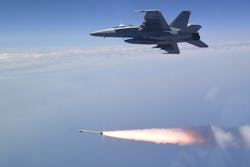Navy orders AGM-88E2 AARGM anti-radar missiles with GPS/INS guidance for the government of Australia
PATUXENT RIVER NAS, Md. – U.S. Navy air warfare experts are ordering a batch of the AGM-88E2 Advanced Anti-Radiation Guided Missile (AARGM) to equip combat aircraft of the Australian military.
Officials of the Naval Air Systems Command at Patuxent River Naval Air Station, Md., announced a $35.6 million order Wednesday to the Northrop Grumman Corp. Mission Systems segment in Northridge, Calif., for lot 11 full-rate-production of the AARGM anti-radar missile.
The order includes full-rate production lot 11 of the AGM-88E2 AARGM all-up round tactical missiles; captive air training missiles; guidance sections; and control sections.
The order also includes High-Speed Anti-Radiation Missiles (HARM) rocket motors; warheads; control sections; G-Code all-up rounds; G-Code captive air training missiles; M-Code Global Positioning System receivers; test equipment; containers; spare and repair parts; software; and logistical support for Australia.
AARGM is the newest version of the AGM-88 missile, and is compatible with U.S. and allied strike aircraft, including the F/A-18 fighter bomber, EA-18G electronic warfare jet, F-16, and F-35.
The AARGM features an advanced digital anti-radiation homing sensor, millimeter wave radar terminal seeker, global positioning system (GPS) guidance, inertial navigation system guidance, net-centric connectivity, and weapon-impact-assessment (WIA) transmit.
The AGM-88E enables the U.S. Navy, U.S. Marine Corps, and allied combat jets to attack and destroy enemy air-defense radar systems and time-critical mobile targets.
The missile offers improved capabilities over the HARM systems it replaces, including advanced signal processing, improved frequency coverage, detection range, and field of view; time-critical, standoff strike; missile-impact zone control to prevent collateral damage; counter-emitter shutdown through active millimeter wave radar terminal guidance; and bomb damage assessment.
The AARGM features new software and enhanced capabilities to counter radar shutdown and passive radar using an additional active millimeter wave seeker. Previous versions of the missile could be spoofed by turning off radar before the weapon could lock on to their signals. The missile has been in full production since 2012.
On this contract Northrop Grumman will do the work in Northridge and Ridgecrest, Calif., and should be finished by March 2025.
For more information contact Northrop Grumman Mission Systems online at www.northropgrumman.com, or Naval Air Systems Command at www.navair.navy.mil.
About the Author
John Keller
Editor-in-Chief
John Keller is the Editor-in-Chief, Military & Aerospace Electronics Magazine--provides extensive coverage and analysis of enabling electronics and optoelectronic technologies in military, space and commercial aviation applications. John has been a member of the Military & Aerospace Electronics staff since 1989 and chief editor since 1995.

